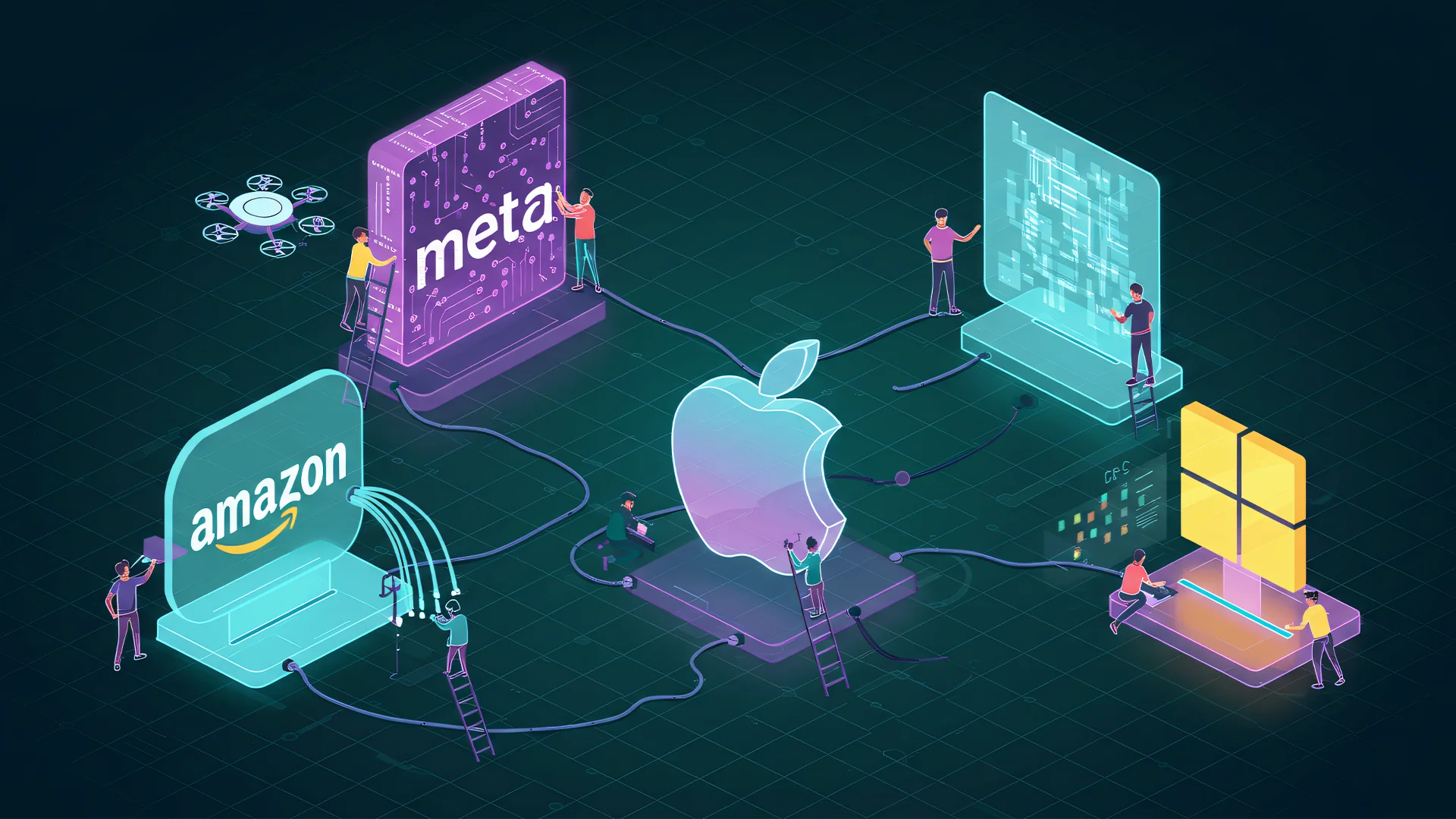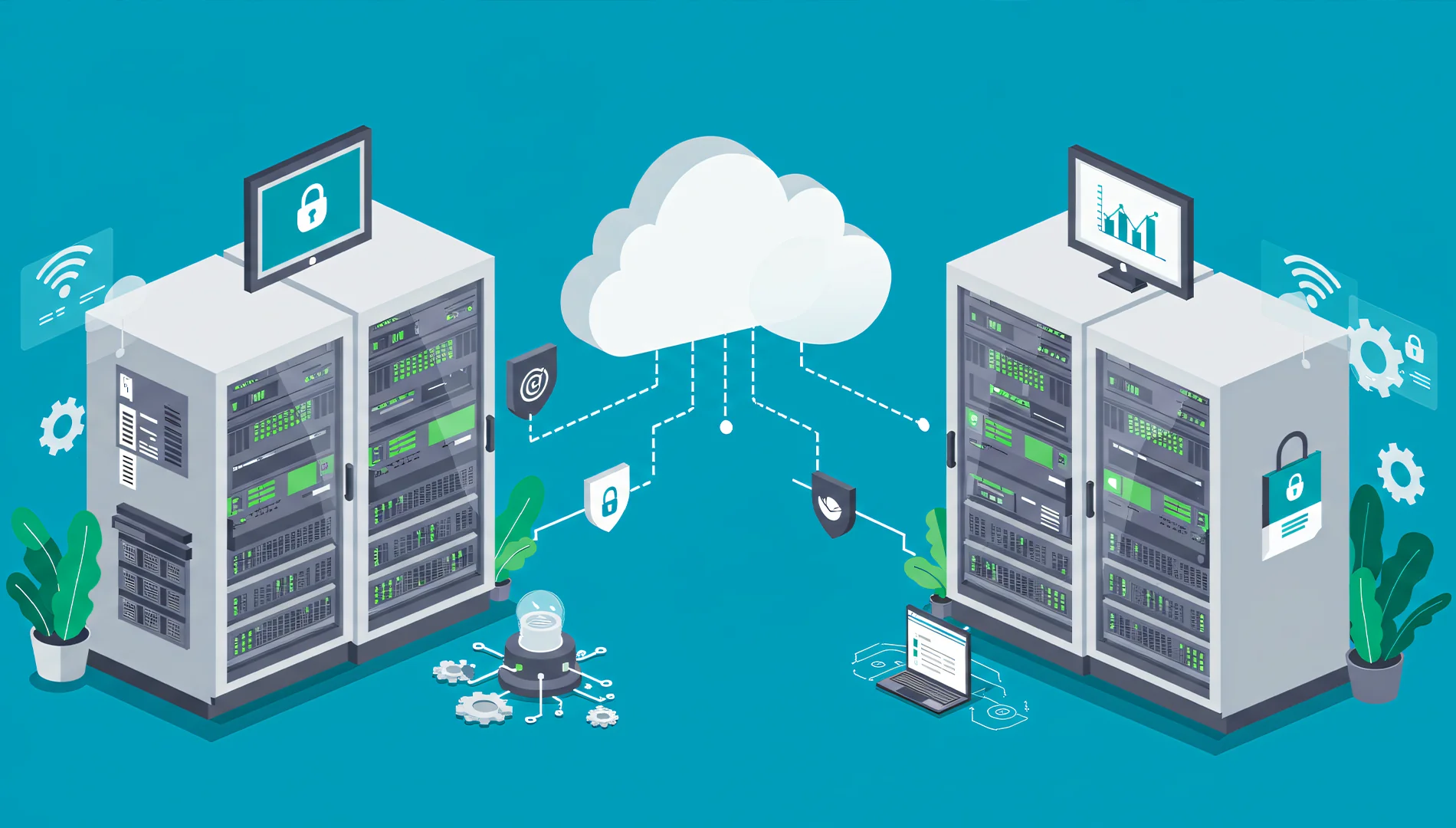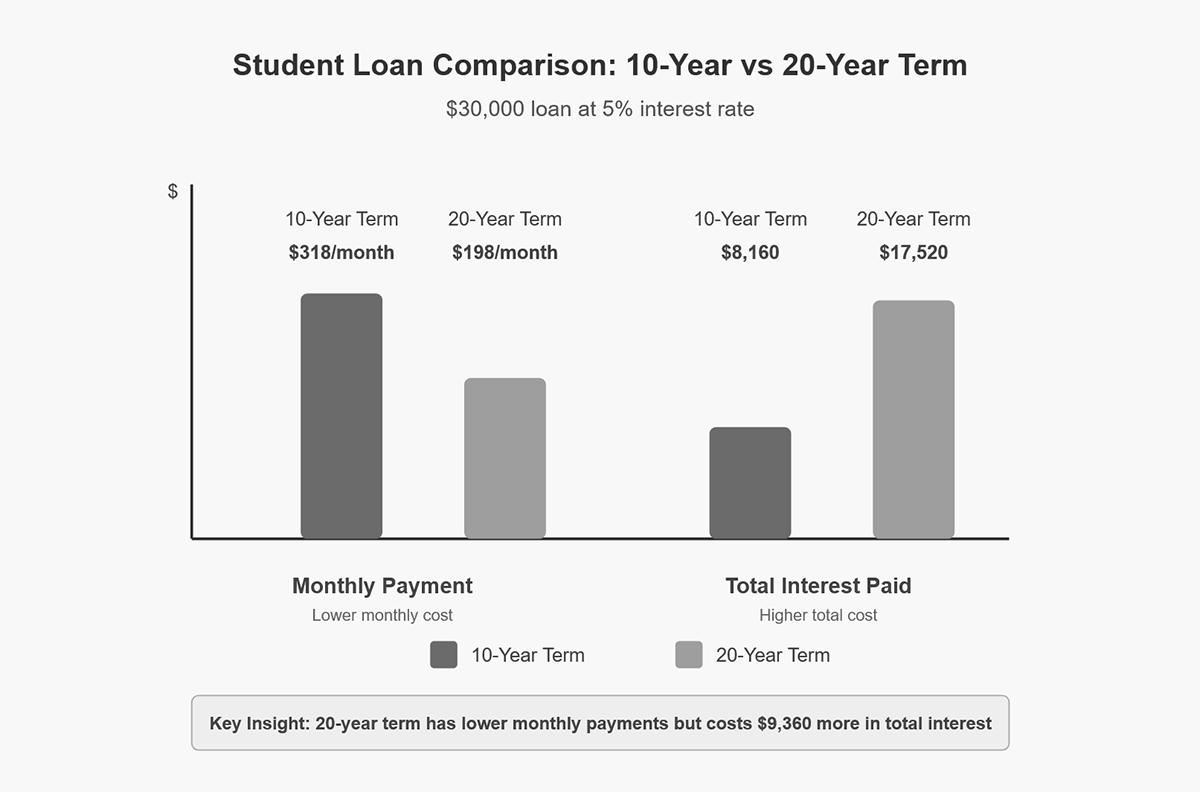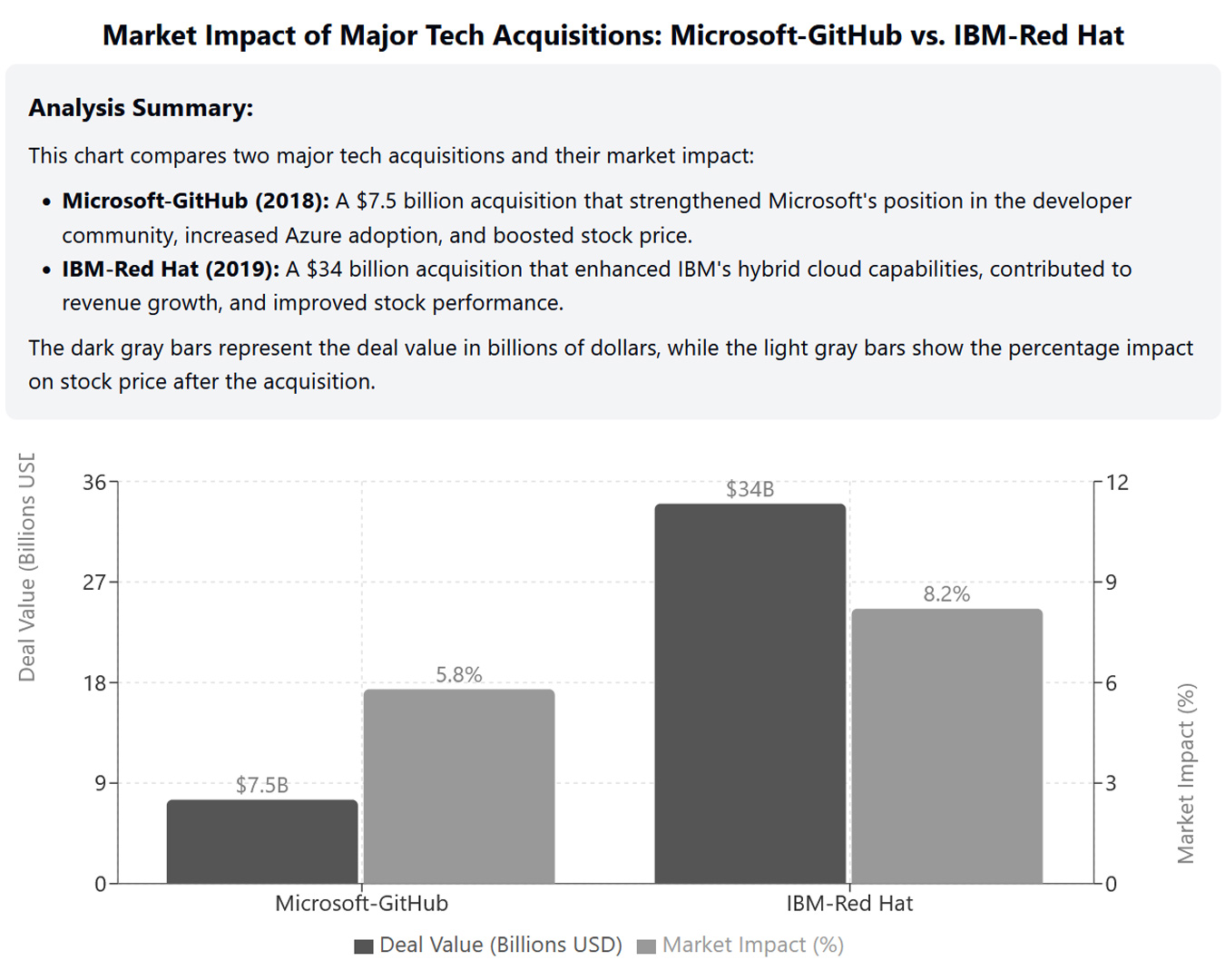Hey there! Let’s talk about Big Tech companies and how they’re constantly reshaping our digital world and financial future.
These tech giants are driving innovation at a rapid pace while also dealing with more regulatory eyeballs on them than ever before.
If you want to really get what’s happening with these companies (and trust me, you should), you’ll get some pretty valuable insights whether you’re putting money into the market, working in tech, or just trying to balance your financial life a bit better.
Big Tech Companies: Definition and Financial Impact
Ever wondered what makes a company earn that fancy “Big Tech” label? I mean, these corporations have their fingers in practically everything, right? They’ve got enormous influence over global markets, where innovation heads next, and pretty much every digital thing we touch daily.
When they make decisions, it’s like dropping a stone in a pond – the ripples affect economies worldwide, job markets, privacy stuff, and yeah… your financial well-being too.
So, what exactly makes a company “Big Tech”?
We’re talking about the biggest, most powerful technology companies with serious market muscle. These guys have massive market caps, global reach that’s kind of mind-boggling, and they basically control the digital platforms and services we can’t live without. They’re like the gatekeepers to digital life for billions of people.
This whole “Big Tech” thing started with that FAANG acronym – you know, Facebook (now Meta), Apple, Amazon, Netflix, and Google (now Alphabet). But things have definitely changed as tech has evolved.
Companies like Microsoft have muscled their way into this exclusive club because, well, they’re absolutely crushing it with market dominance and leading innovation.
How to Identify a Big Tech Company: 5 Key Traits
So what really makes Big Tech different from other huge corporations? For starters, they run these platform-based business models that create incredibly powerful network effects.
They’re also sitting on mountains of user data (yours and mine!), which gives them some serious competitive edges. And man, the money they pour into cutting-edge research? It’s astronomical.
- Substantial Market Capitalization: These guys are usually among the world’s most valuable companies
- Global User Base: We’re talking hundreds of millions to billions of users (yeah, with a “b”)
- Platform Dominance: They control the digital infrastructure we all rely on
- Data Assets: They’ve got more user data than anyone’s ever had in history
- Innovation Leadership: They’re pushing technological advancement across practically everything
Sure, market caps go up and down all the time, but these companies consistently rank among the most valuable businesses on the planet.
And their economic influence? It goes way beyond just what they sell directly – they affect entire industries and probably your investment portfolio too.
5 Ways Big Tech Impacts Your Investment Portfolio
Big Tech is probably affecting your money more than you think. Even if you’re not investing directly in tech, these companies are still shaping your portfolio through their huge presence in indices like the S&P 500.
1. Understanding Index Concentration Risk in Investments
Have you noticed how tech-heavy the major indices have become? If you look closely, tech companies like Apple, Microsoft, and Amazon make up a huge portion of the market now.
It’s something to be aware of when you’re looking at your portfolio. Forbes even points out how tech stocks dominate the market more than ever before.
2. Effective Diversification Strategies for Your Portfolio
So, how do you make sure your portfolio stays balanced? Well, financial experts often suggest diversifying to reduce the risk of putting too much into one sector. Tech’s great, but it’s also pretty volatile, so it’s good to have a mix.
3. Long-Term Investment Strategies for Sustainable Growth
We all know tech isn’t going anywhere anytime soon. But what about over the long run? How might this dominance affect your investments down the line? Some experts say it’ll keep growing, while others think things might shift with new regulations or market changes.
4. Evaluating Value Beyond Tech Growth in Investments
It’s easy to get caught up in the hype about growth, right? But don’t forget to look at the basics. Strong fundamentals like profitability and real innovation are what make these companies worth investing in—not just “growth at all costs.”
5. Why Big Tech’s Systemic Importance Matters
Big Tech isn’t just about the companies themselves—it impacts the entire market. Their performance can actually shake up the stability of the broader economy, which is pretty astonishing when you stop and think about it. Understanding their role in the market is key to making smart investment decisions.
Top 5 Big Tech Leaders Shaping Our Digital Future

When folks talk about “Big Tech,” they’re usually thinking about those few super influential tech corporations that are basically designing our digital lives.
These companies have achieved a level of market dominance that’s pretty much unprecedented, and they keep expanding into new tech territories. The exact lineup changes as market conditions, new innovations, and competitive pressures reshape things.
Apple: Hardware to Services Revenue Revolution
Apple isn’t just about iPhones and MacBooks anymore. Its real game? Services. App Store, Apple Music, iCloud, and TV+ now bring in billions, locking users into its ecosystem.
Ever tried switching from Apple? It’s tough. Everything just works together, and that’s the plan. Once you’re in, you stay. And with privacy as a selling point, trust in Apple keeps growing.
But not everything’s perfect. Regulators are pushing back on App Store policies and right-to-repair debates. Even so, Apple keeps evolving—and let’s be honest, they know how to win.
Microsoft: Cloud Computing Dominance Strategy
Remember when Microsoft was just about Windows and Office? Well, now it’s a cloud powerhouse. Azure competes directly with AWS, while Microsoft 365 is essential in offices everywhere.
Their strategy? It’s all about balancing enterprise services, consumer products, and developer tools. This mix keeps revenue steady even during market shifts. Plus, their smart AI investments give them a big competitive edge.
Subscription-based services like Microsoft 365 keep the money flowing predictably—something Wall Street loves. But, of course, regulators are taking a closer look at Microsoft’s acquisitions, especially the big ones.
Alphabet: From Search Engine to Tech Conglomerate
You probably know Google as the search engine giant, but its parent company, Alphabet, is much more than that.
While search still brings in most of their revenue, the Alphabet structure lets them explore big ideas. From self-driving cars to healthcare breakthroughs, they’re diving into all kinds of new tech.
Their advertising model has worked well for years. Still, changes in privacy laws are shaking things up. On top of that, Google Cloud is becoming a bigger part of their business. This shift helps them rely less on ads.
However, they are facing investigations into potential practices that limit competition in several countries, which could affect their future plans.
Amazon: E-commerce Giant’s Tech Infrastructure Play
Amazon didn’t just change retail—it reinvented it. And the biggest surprise? Amazon Web Services (AWS), which started as an internal tool, is now their most profitable business.
It proves how Big Tech isn’t just about gadgets—it creates entirely new industries. And their logistics network? No other tech company runs operations at this scale.
Amazon’s strategy is all about the customer. Convenience and selection always come first, even if it means lower profits at times. And Amazon Prime? It keeps users inside their ecosystem, making it easier to spend more. But not everything is smooth.
Labor disputes, sustainability issues, and increasing pressure over their market dominance remain big challenges.
Meta: Social Media Evolution and Metaverse Future
Meta (formerly Facebook) is a leading example of how social media platforms evolve. With Instagram, WhatsApp, and Messenger, they connect billions globally, creating a highly engaged digital ecosystem.
Their ad targeting technology delivers precise audience reach, generating massive revenue, even though users don’t pay for access.
Looking ahead, Meta is investing heavily in virtual and augmented reality, shaping the next digital transformation.
But challenges remain. Content moderation, privacy concerns, and tighter regulations keep growing. As social platforms expand, so does the debate on their real impact on society and online behavior.
Big Tech Revenue Models: 4 Profit-Generating Strategies

Big Tech companies make money in different ways, and their strategies often change over time. Understanding these business models helps you evaluate their financial performance and whether they can sustain it. And what’s interesting is how these approaches are increasingly influencing how companies in other sectors structure their own businesses.
How Advertising Powers Tech Giants’ Growth
Companies like Alphabet and Meta make most of their money through advertising, using your data to target ads with scary precision. This model typically gives you free services while monetizing your attention and information. How well it works depends on:
- Data Collection Capabilities: How good they are at gathering relevant user information
- Targeting Precision: How accurately they match ads to receptive audiences
- Engagement Metrics: How well they keep users active on their platforms
- Advertiser Relationships: How successful they are at attracting commercial clients
This approach has been incredibly profitable, but it’s facing more scrutiny around privacy practices and market concentration. Regulatory changes and platform policies affecting data collection are forcing these companies to adapt.
Hardware-Software Ecosystem Financial Benefits
Apple is the poster child for integrating hardware sales with software services, creating ecosystems that keep you buying products within their brand. This model combines:
- Premium Hardware Margins: Making substantial profits on physical devices (have you seen Apple’s margins?)
- Recurring Service Revenue: Generating ongoing income through subscriptions
- Ecosystem Lock-In: Creating switching costs that keep customers around
- Brand Premium: Charging higher prices because of their reputation and user experience
This approach provides stable revenue while encouraging long-term customer relationships. But it requires constant innovation to justify those premium prices and faces pushback from repair rights advocates and app marketplace regulators.
Cloud Computing: Big Tech’s Enterprise Revenue Engine
Amazon (AWS), Microsoft (Azure), and Google (Google Cloud) have built massive businesses providing computing infrastructure and services to other companies. This model includes:
- Subscription and Usage-Based Billing: Charging based on what you consume
- Economies of Scale: Leveraging massive infrastructure investments
- Service Expansion: Continuously adding specialized services with higher margins
- Enterprise Relationships: Building long-term business client partnerships
Cloud services provide predictable, growing revenue streams with strong margins once they reach scale. These businesses require enormous upfront capital, but they create substantial competitive moats through technical complexity and the pain customers feel when trying to switch.
Marketplace Platforms: Scale-Based Profit Models
Amazon’s core business connects buyers and sellers while providing all that fulfillment infrastructure. This approach combines:
- Marketplace Fees: Taking a cut of third-party sales
- Direct Retail Margins: Selling products directly to consumers
- Fulfillment Services: Charging for logistics and delivery
- Membership Programs: Creating loyalty through subscription benefits like Prime
This approach generates thin margins on enormous transaction volumes while building infrastructure that creates competitive advantages. But they have to manage logistics complexity, environmental impacts, and increasing competition from specialized retailers.
Beyond Growth: How to Evaluate Big Tech Investments
When looking at tech companies as potential investments or understanding their impact on your portfolio, you need to look beyond simple growth metrics for a better evaluation. These frameworks matter regardless of which specific companies happen to be dominating the sector right now.
Big Tech’s Sustainable Competitive Advantages
You want to assess whether a company has durable competitive moats that will last through technological change:
- Network Effects: Does the service become more valuable as more people use it?
- Switching Costs: How much pain would customers feel if they tried to change providers?
- Ecosystem Integration: Are products and services interconnected in ways that increase loyalty?
- Data Advantages: Does the company have unique information assets others can’t easily replicate?
- Infrastructure Scale: Have they built physical or digital systems that are super difficult to duplicate?
Financial Health Indicators for Tech Companies
Don’t just look at headline revenue growth – examine the financial health fundamentals:
- Revenue Diversification: Is the company too dependent on a single product or service?
- Margin Trends: Are profit margins stable, getting better, or declining?
- Capital Intensity: How much do they need to keep investing to maintain growth?
- Cash Flow Characteristics: Does the business generate consistent cash?
- Balance Sheet Strength: How well-prepared are they for economic downturns?
Tech Regulation Risks: Impact on Shareholder Value
Evaluate how exposed they are to potential regulatory interventions:
- Market Concentration: Do they dominate their core markets to a concerning degree?
- Data Practices: How vulnerable is their business model to privacy regulation?
- Content Responsibilities: Could they face liability for user content?
- Tax Optimization: Might changing tax policies hurt their profitability?
- Antitrust Exposure: Could they face forced restructuring?
Innovation Power: Measuring Future Growth Potential
Assess the company’s ability to adapt to technological change:
- R&D Investment: How much are they putting into future technologies?
- Talent Acquisition: Can they attract the best technological expertise?
- Innovation Culture: Does their organizational structure help or hinder new ideas?
- Acquisition Strategy: How good are they at identifying and integrating external innovation?
- Response to Disruption: How have they handled previous technological shifts?
5 Major Trends Transforming Big Tech Today
Big Tech companies are constantly navigating evolving technological, regulatory, and market environments. Understanding the major trends affecting these corporations gives you valuable insights whether you’re investing or working in the industry. And these trends often point to broader technological directions that will eventually impact many other sectors and your financial planning options.
AI Revolution: Big Tech’s New Growth Frontier
Artificial intelligence has moved from experimental technology to essential business infrastructure. This shift creates both opportunities and challenges for established technology companies and potential investment considerations for individuals.
- Industry-Specific AI Solutions: Customized for healthcare, finance, manufacturing, and more
- Multimodal AI Systems: Combining text, image, audio, and video understanding
- Edge AI Deployment: Bringing intelligence directly to devices
- AI Governance Frameworks: Establishing responsible development standards
- Synthetic Data Generation: Creating training resources while preserving privacy
The productivity improvements from AI could potentially transform business economics across sectors. But the technology also raises some deep questions about data privacy, information reliability, and effects on labor markets that may influence regulatory responses and social acceptance.
Global Tech Regulation: New Compliance Challenges
Government oversight of technology companies has increased substantially worldwide. And regulatory approaches vary significantly between regions, creating complex compliance environments that companies have to navigate carefully.
The European Union has established comprehensive frameworks addressing digital markets, services, and data protection. Meanwhile, other jurisdictions have pursued targeted enforcement or sector-specific regulation. This evolving regulatory landscape creates both compliance costs and potential competitive impacts that vary by company and business model.
Financial implications of this trend include increased compliance costs, potential business model adjustments, and in some cases, structural changes to how companies operate across borders. Companies with diverse revenue streams and adaptable business models might navigate these challenges more successfully.
Environmental Strategy: Tech’s Green Transformation
Environmental concerns have moved from “nice-to-have” considerations to central business strategies. Technology companies are evaluating environmental impacts alongside traditional business metrics, responding to both regulatory requirements and market expectations.
Leading companies have established comprehensive sustainability programs addressing:
- Carbon Emissions: Reducing direct and indirect climate impacts
- Renewable Energy: Transitioning operations to sustainable power sources
- Material Efficiency: Increasing recycled content and repairability
- Supply Chain Responsibility: Extending environmental standards to partners
- Circular Design: Creating products with end-of-life considerations built in
For investors, these initiatives represent both risk management and potential competitive differentiation. Companies demonstrating leadership may benefit from improved brand perception, reduced regulatory exposure, and potentially lower operating costs over time.
Privacy Innovation: Data Protection Technologies
Let’s face it – privacy concerns are reshaping how products get developed in today’s tech world. I’ve noticed big tech companies are now pouring money into privacy tools that work great but collect way less of your personal data.
This shift isn’t random, though. Between those tough European regulations and California’s privacy laws, plus people getting smarter about their info, something had to change. And honestly? Technologies like differential privacy (which fuzzes your data), on-device learning, and better encryption now let companies personalize stuff without knowing everything about you.
For businesses exploring cutting-edge privacy solutions, our Business and Technology sections offer valuable resources. Yet, the strategic integration of these privacy-focused approaches can create advantages, though they may challenge traditional business models.
From an investment standpoint, this privacy revolution potentially favors companies with revenue streams less dependent on targeted advertising. Consequently, organizations demonstrating privacy leadership typically build stronger trust relationships, ultimately reducing churn rates and mitigating regulatory compliance risks in our privacy-conscious marketplace.
Web3 and Decentralized Tech: Big Tech’s Response
Emerging technologies including blockchain, cryptocurrencies, and decentralized applications present both challenges and opportunities for established technology companies. These approaches potentially reduce platform dependency while enabling new transaction models and digital asset categories.
Big Tech companies have responded in various ways—developing their own blockchain initiatives, integrating with existing cryptocurrencies, or keeping their distance from the sector. At the same time, dedicated Web3 companies have developed parallel infrastructure challenging aspects of centralized platforms.
The long-term implications remain uncertain, with potential outcomes ranging from marginal impact to fundamental restructuring of digital commerce and services. For investors, this uncertainty suggests moderate, diversified exposure rather than concentrated positions dependent on specific technological outcomes.
Tech Investment Balance: Financial Planning Strategies

The outsized influence of technology companies in modern markets requires thoughtful consideration when developing financial plans. Whether you’re actively investing or simply managing retirement accounts, understanding how to balance technology exposure contributes to financial stability.
Index Fund Tech Exposure: Hidden Concentration Risk
Major stock indices have grown increasingly concentrated in top technology companies, creating potential risk for passive investors. Index funds tracking these benchmarks may have greater technology exposure than many investors realize.
- Understand Your Current Exposure: Take a look at your fund holdings to quantify technology allocation
- Consider Specialized Indices: Explore alternatives that limit single-sector concentration
- Evaluate Equal-Weight Options: Research indices that don’t give higher weight to largest companies
- Monitor Changes Over Time: Regularly reassess as market composition evolves
- Balance With Other Assets: Complement with investments having low correlation to technology
Tech Sector Cycles: Historical Patterns for Investors
Technology leadership within markets often cycles as innovations mature and valuation expectations shift. Understanding these patterns helps maintain perspective during both sector outperformance and underperformance periods.
- Historical Context: Recognize previous technology cycles and how they eventually played out
- Valuation Awareness: Consider current valuations relative to historical ranges
- Growth Expectation Realism: Evaluate whether market growth assumptions seem sustainable
- Lifecycle Assessment: Identify where technologies fall in adoption and maturity curves
- Counter-Cyclical Planning: Maintain some exposure to sectors with different economic sensitivities
Global Tech Investing: Beyond U.S. Big Tech Giants
While American companies dominate global technology conversations, significant innovation occurs worldwide. International exposure provides both diversification and participation in different technology approaches and markets.
- Regional Technology Leaders: Research dominant companies in other major economies
- Emerging Market Innovation: Consider exposure to high-growth technology regions
- Regulatory Arbitrage: Understand how varying regulatory environments affect competitiveness
- Cultural Differentiation: Recognize how local preferences shape successful business models
- Currency Considerations: Account for exchange rate effects on investment returns
Private Tech Markets: Alternative Investment Access
Public technology companies represent only part of the innovation landscape. Private companies often develop groundbreaking approaches before public market availability.
- Venture Capital Funds: Consider limited exposure through specialized investment vehicles
- Private Equity Technology Funds: Explore later-stage private company investments
- Pre-IPO Opportunities: Research platforms offering qualified investor access to maturing private companies
- Angel Investing Networks: Evaluate direct early-stage investment through structured groups
- Technology-Focused REITs: Invest in specialized real estate supporting technology infrastructure
Big Tech FAQ: Essential Investor Questions Answered
Navigating tech investments can be tricky, but with the right insights, you can save time and make smarter decisions. Below, you’ll find direct answers to your key questions about Big Tech.
Which Companies Are Considered Big Tech?
Today’s Big Tech landscape primarily includes Apple, Microsoft, Alphabet (Google), Amazon, and Meta (Facebook). Moreover, this elite group—often called the “Tech Giants” or “FAANG+M”—dominates global markets with trillion-dollar valuations. Additionally, companies like NVIDIA, Tesla, and emerging AI leaders are increasingly joining these ranks as technology redefines industries worldwide. Naturally, this composition evolves through market shifts, acquisitions, and innovation breakthroughs.
How Do Big Tech Companies Make Their Billions?
Big Tech generates revenue through diversified business models, consequently creating multiple profit engines that drive consistent growth:
- Apple: Hardware sales (iPhone, Mac, wearables) provide 70% of revenue, while high-margin services grow at double-digit rates
- Microsoft: Enterprise cloud services (Azure), productivity software subscriptions, and gaming form a balanced portfolio
- Google: Digital advertising across search and YouTube generates 80% of income, supplemented by cloud computing
- Amazon: E-commerce marketplace fees, AWS cloud infrastructure, and Prime subscriptions create a reinforcing ecosystem
- Meta: Targeted advertising across social platforms, with emerging revenue from virtual reality and metaverse initiatives
What Are the Biggest Challenges Facing Tech Giants Today?
Big Tech faces unprecedented challenges that potentially threaten their market dominance and growth trajectories:
- Regulatory Crackdown: Antitrust investigations, digital regulations, and possible forced breakups loom large
- Privacy Revolution: Major privacy laws and evolving data protection regulations restrict their data collection capabilities
- Market Saturation: Core product adoption is plateauing in developed markets, therefore requiring expansion elsewhere
- AI Talent Wars: Fierce competition for limited artificial intelligence specialists drives compensation costs skyward
- Climate Commitments: Meeting aggressive carbon-neutral pledges while data centers consume increasing energy
Furthermore, cybersecurity threats target critical infrastructure, meanwhile content moderation controversies plague social platforms.
How Are Big Tech Companies Addressing Environmental Sustainability?
Tech Giants are implementing comprehensive sustainability strategies to reduce environmental impact while supporting business growth:
Amazon has committed billions to its Climate Pledge Fund supporting net-zero carbon goals. Similarly, Microsoft’s carbon negative initiative includes removing historical emissions since founding. Furthermore, Apple targets carbon neutrality across its entire supply chain, while Google continues advancing its longstanding carbon-neutral operations.
Consequently, these companies innovate with efficient chip design, liquid cooling systems, and renewable energy investments.
What Regulatory Changes Should Tech Investors Monitor?
The regulatory landscape for technology companies continues evolving globally, thus creating investment risks and opportunities:
The EU leads with strict digital regulations including comprehensive market acts and AI frameworks establishing mandatory requirements. Meanwhile, the US pursues antitrust cases against major platforms while considering federal privacy legislation. In contrast, China implements stringent data security rules affecting tech operations.
As a result, Tech Giants have expanded regulatory compliance teams substantially, investing billions in adaptive technology.
Big Tech’s Financial Future: Innovation and Regulation
Today’s tech giants truly dominate our global economy. Indeed, they shape how we invest and drive innovation across countless industries. Moreover, their enormous market influence provides key context for planning your finances in this digital age.
As AI technologies continue advancing, digital transformation is reshaping businesses everywhere. Consequently, tech leadership remains absolutely vital to economic growth. Meanwhile, new regulations are addressing concerns about market competition, data privacy, and content moderation—ultimately balancing innovation with protection.
Smart investors understand that tech exposure needs careful balance in any portfolio. In fact, neither overloading nor completely avoiding the sector makes sense. Furthermore, the dance between technological advancement, regulatory oversight, and corporate responsibility will impact your returns, career options, and financial security.
To navigate this tricky landscape well, focus first on understanding basic business models. Additionally, learn to evaluate companies beyond simple growth numbers and recognize tech cycles. This approach helps you build sustainable strategies aligned with long-term goals while still capturing exciting digital opportunities.
Disclaimer: This analysis provides educational information and is not intended as investment advice. Always conduct thorough research or consult qualified financial professionals before making investment decisions.
Sources & References
Financial & Industry Research
Financial & Business Publications
- Harvard Business Review – Platform economics and Big Tech business models
- Financial Times – “Big Tech and the Future of Global Finance”
- The Economist – Special reports on tech industry economics
- Bloomberg Technology – Quarterly financial analysis of tech giants
- McKinsey Global Institute – “The Economic Impact of AI and Big Tech”
Research & Academic Sources
- MIT Technology Review – Innovation strategies of major tech companies
- Stanford Digital Economy Lab – Market concentration research
- Journal of Business Strategy – “Competitive Advantages in Platform Business Models”
- NBER – Economic research papers on Big Tech market effects
Regulatory & Government Reports
- European Commission – Digital Markets Act and regulatory frameworks
- Federal Trade Commission – Technology sector competition analysis
- World Economic Forum – “Global Technology Governance Report”
- OECD – “Going Digital: Shaping Policies for Digital Transformation”
Industry Analysis
- Deloitte – Annual “Tech Trends” reports
- PwC – “Global Top 100 Companies by Market Capitalization”
- CB Insights – Tech investment and acquisition analysis
Sustainability Reports
- Apple Environmental Progress Report – Annual sustainability reporting
- Microsoft Sustainability Report – Carbon negative initiatives





































